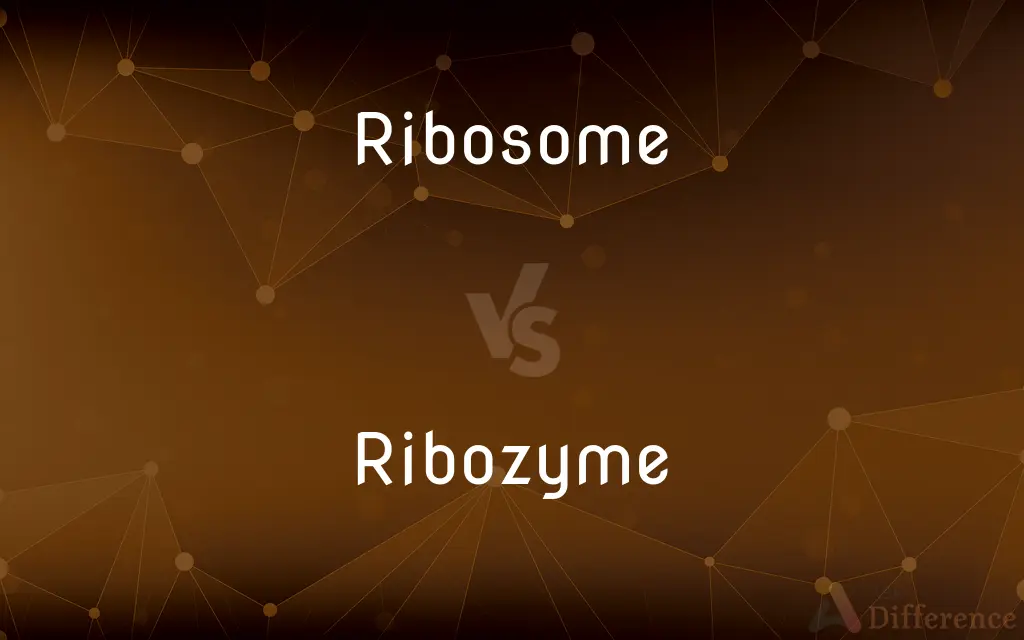Ribosome vs. Ribozyme — What's the Difference?
By Tayyaba Rehman & Urooj Arif — Updated on April 8, 2024
Ribosomes are cell organelles that synthesize proteins, while ribozymes are RNA molecules with catalytic capabilities.

Difference Between Ribosome and Ribozyme
Table of Contents
ADVERTISEMENT
Key Differences
Ribosomes are essential organelles found in all living cells, playing a critical role in the process of translating mRNA into proteins, a fundamental aspect of cellular function and gene expression. In contrast, ribozymes are specialized RNA molecules capable of catalyzing specific biochemical reactions, often involving the cleavage and ligation of RNA, without the need for protein enzymes. While ribosomes are complex structures composed of both ribosomal RNA (rRNA) and proteins, ribozymes are entirely nucleic acid-based, showcasing the versatility of RNA beyond its role in protein synthesis.
The function of ribosomes is universally vital across all forms of life, from bacteria to human cells, emphasizing the central dogma of molecular biology: DNA is transcribed into RNA, which is then translated into proteins by ribosomes. Ribozymes, on the other hand, highlight the catalytic potential of RNA molecules, suggesting an ancient evolutionary role where RNA acted as both genetic material and catalyst, supporting the RNA world hypothesis. This distinction underlines the fundamental differences in their roles within the cell; ribosomes are workbenches for protein synthesis, whereas ribozymes perform specific catalytic functions that can influence RNA processing and gene regulation.
Ribosomes can be found floating freely within the cytoplasm or attached to the endoplasmic reticulum, forming the rough ER, indicative of their role in producing proteins for both internal and external use by the cell. Ribozymes are often involved in more targeted processes, such as splicing introns from precursor mRNA in the nucleus or catalyzing the self-replication of RNA molecules in some viruses. This locational difference underscores their distinct functionalities within various cellular compartments and processes.
The size and complexity of ribosomes, with their large and small subunits, allow for the intricate process of decoding mRNA and linking amino acids into polypeptide chains. Ribozymes, being much smaller and consisting of a single RNA molecule, rely on their three-dimensional structure to bind to specific substrates and catalyze reactions, demonstrating the diversity of RNA's structural and functional capabilities.
Despite their differences, both ribosomes and ribozymes are crucial for life as we know it. Ribosomes' ability to produce proteins enables cells to perform a vast array of functions necessary for survival and growth, while ribozymes provide insight into the primitive mechanisms of life and continue to play essential roles in RNA processing and regulation, bridging the worlds of nucleic acids and proteins in fascinating ways.
ADVERTISEMENT
Comparison Chart
Nature
Cellular organelle
Catalytic RNA molecule
Composition
RRNA and proteins
RNA only
Function
Protein synthesis
Catalyzing specific biochemical reactions
Location
Cytoplasm, attached to the endoplasmic reticulum
Varies, including nucleus and cytoplasm
Role in Evolution
Central to the flow of genetic information
Supports RNA world hypothesis
Compare with Definitions
Ribosome
Found in all living cells, highlighting their universal importance.
Both prokaryotic and eukaryotic cells contain ribosomes.
Ribozyme
Catalyzes specific biochemical reactions.
Some ribozymes splice introns from RNA transcripts.
Ribosome
Plays a crucial role in gene expression.
Ribosomes ensure the accurate translation of genetic information into functional proteins.
Ribozyme
Does not require proteins for its catalytic activity.
Ribozymes can perform their functions without the help of proteins.
Ribosome
A cellular organelle responsible for protein synthesis.
Ribosomes translate mRNA into polypeptide chains.
Ribozyme
Provides evidence for the RNA world hypothesis.
The catalytic abilities of ribozymes suggest an ancient world dominated by RNA.
Ribosome
Consists of a large and a small subunit.
The 70S ribosome in bacteria is made of 30S and 50S subunits.
Ribozyme
An RNA molecule with enzymatic activity.
The ribosome is a ribozyme critical for peptide bond formation.
Ribosome
Can be free-floating or membrane-bound.
Membrane-bound ribosomes synthesize proteins destined for secretion.
Ribozyme
Found in various cellular processes.
Ribozymes are involved in RNA processing and replication.
Ribosome
Ribosomes () are macromolecular machines, found within all living cells, that perform biological protein synthesis (mRNA translation). Ribosomes link amino acids together in the order specified by the codons of messenger RNA (mRNA) molecules to form polypeptide chains.
Ribozyme
Ribozymes (ribonucleic acid enzymes) are RNA molecules that have the ability to catalyze specific biochemical reactions, including RNA splicing in gene expression, similar to the action of protein enzymes. The 1982 discovery of ribozymes demonstrated that RNA can be both genetic material (like DNA) and a biological catalyst (like protein enzymes), and contributed to the RNA world hypothesis, which suggests that RNA may have been important in the evolution of prebiotic self-replicating systems.
Ribosome
A structure composed of RNA and protein, present in large numbers in the cytoplasm of living cells and serving as the site for assembly of polypeptides encoded by messenger RNA.
Ribozyme
An RNA molecule that acts as a catalyst, especially for the cleavage of RNA strands at specific sites.
Ribosome
A small organelle found in all cells; involved in the production of proteins by translating messenger RNA.
Ribozyme
A fragment of RNA that can act as an enzyme.
Ribosome
An organelle in the cytoplasm of a living cell; ribosomes attach to mRNA and move down it one codon at a time and stop until tRNA brings the required amino acid; when a ribosome reaches a stop codon it falls apart and releases the completed protein molecule for use by the cell;
The ribosome is the site of protein synthesis
Common Curiosities
What evidence do ribozymes provide for the RNA world hypothesis?
Ribozymes support the RNA world hypothesis by demonstrating that RNA molecules can have both genetic and catalytic functions, suggesting that early life forms may have relied solely on RNA.
How do ribosomes assemble?
Ribosomes assemble from their large and small subunits, which come together on an mRNA strand to begin protein synthesis.
What is the primary function of ribosomes?
Ribosomes are responsible for synthesizing proteins by translating the genetic information encoded in mRNA.
Can ribozymes catalyze reactions other than RNA splicing?
Yes, ribozymes can catalyze a variety of reactions, including RNA cleavage, ligation, and even peptide bond formation in the case of the ribosome.
How do ribosomes and ribozymes relate to the flow of genetic information?
Ribosomes play a direct role in the central dogma of molecular biology by translating RNA into proteins, while ribozymes, particularly the ribosomal RNA within the ribosome, reveal the ancient catalytic roles of RNA.
How do ribozymes work?
Ribozymes catalyze chemical reactions involving RNA or other substrates by folding into complex three-dimensional structures that allow specific binding and catalysis.
Are ribosomes found in all types of cells?
Yes, ribosomes are found in all living cells, including both prokaryotes and eukaryotes, underscoring their essential role in biology.
Is there a difference in ribosomes between prokaryotes and eukaryotes?
Yes, prokaryotic ribosomes are smaller (70S) and differ in protein and rRNA composition from the larger eukaryotic ribosomes (80S).
Can ribozymes be used in biotechnology?
Yes, ribozymes have potential applications in biotechnology and medicine, including gene therapy and the development of novel therapeutic agents due to their specificity and catalytic capabilities.
What makes ribozymes unique among biological catalysts?
Ribozymes are unique because they are made entirely of RNA, proving that RNA can function as a catalyst in the absence of proteins.
Share Your Discovery

Previous Comparison
Suspension vs. Expulsion
Next Comparison
Cero vs. ZeroAuthor Spotlight
Written by
Tayyaba RehmanTayyaba Rehman is a distinguished writer, currently serving as a primary contributor to askdifference.com. As a researcher in semantics and etymology, Tayyaba's passion for the complexity of languages and their distinctions has found a perfect home on the platform. Tayyaba delves into the intricacies of language, distinguishing between commonly confused words and phrases, thereby providing clarity for readers worldwide.
Co-written by
Urooj ArifUrooj is a skilled content writer at Ask Difference, known for her exceptional ability to simplify complex topics into engaging and informative content. With a passion for research and a flair for clear, concise writing, she consistently delivers articles that resonate with our diverse audience.
















































